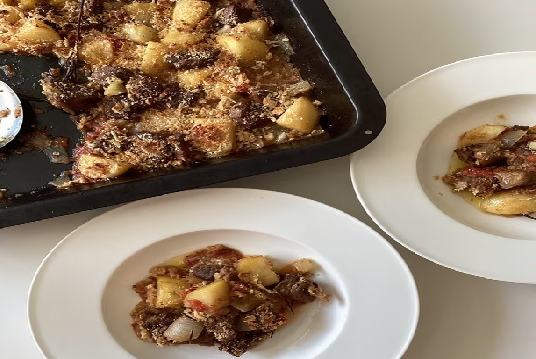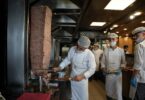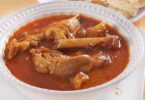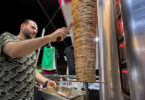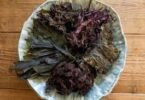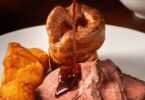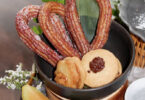Rachel Roddy
A small, gnocchi-like pasta called pisarei, with beans and just enough tomato sauce to bring them together. Fried chicken and courgettes braised in tomato sauce, made by Mum. A baseball-sized scotch egg (with kedgeree) from the Rubicon pop-up in West Bay, Dorset. Deep-fried anchovies with roast red peppers. Stuffed olives eaten from a paper cone at a train station.
Pasta with sardines, fennel and rubble on top, at home. A friend’s apple-and-almond cake, enjoyed in her garden. Lamb baked with potato, tomato and breadcrumbs. Things I have enjoyed lately have an ingredient in common – kneaded into the dough for pasta; used in the coating for chicken, egg, anchovies and olives; toasted into rubble; both in a cake mixture and lining the tin; giving the lamb a crisp finish. Versatile and everywhere, breadcrumbs are the Kevin Bacon of ingredients.
And not just lately. In a poll I conducted with one other person, we decided that, after olive oil and salt, breadcrumbs are the hardest-working ingredient in our kitchens. Also, a shapeshifter, as varied as the loaves from which they come. And, arguably, more varied than the loaves, because of the many grades of crumb, from soft rags to the finest grit and everything in between, much of which has to do with the ageing process.
And, in their shapeshifting, they also change the natures of the dishes they are part of: soft, white crumbs behave differently in the frier from fine sandy ones, and fried chicken tastes differently as a result. Preference steps in, too. On top of sardine pasta, I like soft crumbs, pulsed in the blender, then fried until they look a bit like the fragments of chips and batter that collect in the folds of fish-and-chip paper. My partner prefers the fine crumbs, also made in the blender, but from really dry bread and toasted in olive oil.
Every time I return the blade to my small blender, I’m reminded how hard bread can become if it is left long enough. It was a rock of white, unsalted bread that turned one flat blade into a hoe. I should have toasted it slightly first, which turns hard into brittle, and therefore easier to blend. I try to keep bags of both soft, fresh and very dry breadcrumbs in the freezer. If they really are dry, they will be OK in a jar, too, but dampness and mould may creep in.
You can use very soft or very dry and everything in between for this week’s recipe, which is inspired by a dish served at a long-established but enterprising trattoria in Matera called Stano. The ideal vessel is a pan or dish that can go on the stovetop as well as in the oven; otherwise, use a large frying pan and a suitable oven dish. For four, you need 1kg lamb: small chops, boneless legs or neck, all cut into chunks.
Baked but covered, and with plenty of liquid and tomatoes, the final result is somewhere between roasted and braised, all soft underneath and crisp on top, also thanks to the hardest-working one.
Lamb with potato, tomato and breadcrumbs
Serves 4
Olive oil
1kg lamb – small chops, boneless leg or neck, all chopped into chunks
Salt
2 glasses white wine
1 large onion, peeled and sliced
2 large potatoes (about 400g), peeled and diced
3 tomatoes, peeled and crushed
Dried oregano
100g coarse, dry breadcrumbs
1 tbsp grated pecorino
The ideal vessel for this is a pan or terracotta dish that can go both on the stove-top and in the oven; otherwise, use a large frying pan and an oven dish. Warm a little olive oil in a large ovenproof pan, then, working in batches so the pan isn’t crowded, brown the lamb on all sides and lift on to a plate. Once it is all browned, put the lamb back in the pan, add salt and raise the heat. Pour over a glass of white wine and leave to sizzle for a minute or two. (At this stage, if you are using a frying pan, tip the lamb and the cooking juices into an oven dish.)
Scatter over the onion, potatoes, tomatoes, a pinch of salt and a big pinch of dried oregano, toss well, then pour over the remainingglass of white wine (or water).
Cover the pot loosely with foil, bake at 180C (160C fan)/350F/gas 4 for 30 minutes, then remove the foil and bake for another 30 minutes. If at any point the mix seems dry, add more liquid.
Combine the breadcrumbs with the grated pecorino and a tablespoon of olive oil. In the last 10 minutes, stir the pot, top with the breadcrumb mix and return to the oven (with the grill on, too, if possible) for a final crisping.
Courtesy: theguardian

